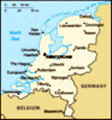COMING SOON HOUSE ADVERTISING ads_leader
My primary purpose for visiting Amsterdam is the van Gogh Museum. I have selected a hotel nearby as well. Prior trips here did not enable a visit, since it either was being built, or being renovated (1998 and 1999). I did see some of this vast collection in a temporary building, as well as two world tours in the U.S. The Amsterdam van Gogh Museum houses the largest collection of the world's most popular artist. Each year, 1.6 million visitors come through, making it the 25th most popular museum in the world. It is the second most visited museum in The Netherlands. The permanent collection consists of more than 200 paintings and 500 drawings. Some of his contemporaries are also on display. The work is categorized into five periods, representing the periods of his life and work: The Netherlands, Paris, Arles, Saint Remy, and Auvers sur Oise. In 1991, twenty paintings were stolen from the Museum, including Potato Eaters. They were recovered 35 minutes later, with three severely torn. It was the largest art theft in the Netherlands since World War 2. In 2002, two more paintings were stolen and never recovered. Two Dutchmen were convicted and served a mere four
and a half year sentence. Among his famous works here are: The Potato Eaters (1885)View of Paris from his room in Lepic (1887)Bedroom in Arles (1888)Sunflowers (1889)Almond Blossoms (1890) Starry Night resides in the permanent collection of the MOMA in New York City. It is often regarded as his finest work, and one of the most recognized paintings in the history of Western culture. Most remarkably, it was painted during the day while in the asylum. Vincent wrote to Theo, "This morning I saw the countryside from my window a long time before sunrise with nothing but the
morning star, which looked very big." Remarkably, van Gogh only sold one or two paintings in his entire lifetime. And Starry Night was twice owned by Theo's (his younger brother) widow. The modern looking main building was designed by Gerrit Rietveld, and completed in 1973 by his partners after his death. The elliptical exhibition wing was designed by Kisho Kurokawa, and opened in 1999. It is located in Museum Square, close to other famous sites, the Concertgebouw, Rijksmuseum, and Stedelijk Museum. I have been to the others numerous times in the past. The Museum also has sculptures by Rodin, and paintings by Monet,
Gauguin, Toulouse-Lautrec, Manet, and Seurat. From the Museum website: Van Gogh was largely self-taught, beginning his education with a powerful focus on figure and landscape drawing. He found he was able to use colored chalk, charcoal, reed pen and pencil to quickly capture images before later adding watercolor detail. He also experimented with lithographs to reach a larger audience. Van Gogh used muted colors in these early years to suit his subjects (peasants and manual workers) but his move to Paris in 1886 showed him the work of the Impressionists and inspired him to use more color. He also began to experiment with broken brush strokes and pointillist technique (see Self-Portrait with a Straw Hat, 1885).In 1888, van Gogh moved to Arles and lived with Gauguin, emulating his friend’s habit of painting from memory. This resulted in more fantastic, less realistic images that used colors according to mood rather than to represent the truth of nature. He was also influenced by Japanese prints, as seen in The Flowering Orchard. Another favorite of art lovers around the world are his famous sunflowers. The Museum website has this to say about it: Van Gogh completed a total of five large paintings of sunflowers in a vase. One of these works is displayed at the Van Gogh Museum. Did you know that he actually planned to produce a series of twelve such canvases with which to decorate his Yellow House in Arles? His
Sunflowers are still often used for home decoration today. Including the hand-painted porcelain tableware designed exclusively for the Van Gogh Museum. This will be my first stop on Friday morning. Then I will probably rent a bicycle and take off for a few days to the beautiful Dutch countryside, in search of the little Dutch boy with his finger in the dike. Or the rosy cheeked little Dutch ladies making cheese in their tiny Dutch kitchens. Recent update (9/30/16): During a press conference today the Chief Public Prosecutor of the district of Naples announced that two missing paintings by Van Gogh have been recovered. It concerns the two paintings that were stolen from the Van Gogh Museum in 2002: Seascape at Scheveningen (1882) and Congregation leaving the Reformed Church in Nuenen (1884/85). The curator who inspected the authenticity and provenance of the works at the request of the Italian Public Prosecutions Department drew a firm conclusion: ‘they are the real paintings!’ Despite a 14‑year journey, the two paintings appear to be in fairly good condition. Both lack their frames and show signs of some damage. It is not yet clear when the paintings will return to Amsterdam.Needless to say, I am on a museum high. First van Gogh, then the famous Night Watch by Rembrandt van Rijn at the Rijksmuseum next door. I forgot how much I missed Europe, though I still prefer Asia. Sidebar: I did not realize what a strong influence Japanese art was on van Gogh. Check it out online.
COMING SOON HOUSE ADVERTISING ads_leader_blog_bottom
Tot: 0.3s; Tpl: 0.01s; cc: 30; qc: 44; dbt: 0.2149s; 1; m:domysql w:travelblog (10.17.0.13); sld: 1;
; mem: 1.3mb








Dancing Dave
David Hooper
Dutch Masters
A visit to the Van Gogh Museum and the Rijksmuseum next door...now that's a feast Gerry. I recently visited Melbourne and thoroughly enjoyed over 200 works by the French master Edgar Degas, so I had just a morsel of what you will enjoy in Amsterdam.